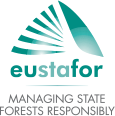EU Restoration Law must be an opportunity to support the health and resilience of EU forests without hindering their sustainable management
PRESS RELEASE[1]
Brussels, 23 June 2022
Even though certain aspects of the proposal still remain unclear and should be better formulated in the upcoming period, the European State Forest Association (EUSTAFOR) generally welcomes the efforts of the European Commission to contribute to the continuous, long-term, and sustained recovery of biodiverse and resilient nature across the EU by restoring ecosystems. This is the overarching objective enshrined in the EU Restoration Law proposal.
EUSTAFOR is in favor of the proposed ecosystem-specific approach and is hoping that differences in restoration needs and points of departure between different ecosystem types and land uses will be properly recognized. EUSTAFOR regrets that the restoration targets are set without a prior assessment of the overall state of ecosystems and the actual need for restoration. This means that an area to be restored could cover millions of hectares, requiring extensive human resources and restoration costs of billions of euros to be covered from sources which have not been well-identified. This creates substantial uncertainty regarding the prospects for the implementation of the new legislation.
Although the approach taken for the restoration of forest habitats listed under the Habitats Directive seems adequate, unfortunately, when it comes to the data to be used for assessing the state of play, tendentious conclusions have prevailed. Namely, the proposal suggests that: “Areas where the habitat types listed in Annex I are in unknown condition[2] shall be considered as not being in good condition.” Not only does this risk creating an unnecessary increased burden, but it casts serious doubts on the data and the methodology behind such assessments. Almost 30% of forest habitats are in unknown condition. Arriving at such results 30 years after the adoption of the Directive risks leading to the perception that the legislation is a lost cause. In that regard, EUSTAFOR has already called[3] for strengthening the existing partnership with Member States and European environmental agency networks to improve compliance and governance at a local level within the existing legislative framework. Without addressing the current drawbacks and discussing possible solutions, serious concerns on further extending reporting obligations may emerge.
Moreover, the establishment of indicators and related thresholds must consider existing proven methodologies and definitions, to avoid a high monitoring burden and incorrect estimations. Policy demands should also, at all times, be coordinated with existing inventories and scientific knowledge. EUSTAFOR underlines the importance of including Member State experts and independent research into the announced revisions of a great number of annexes instead of delegating this role exclusively to the Commission.
While the EU has become highly dependent on the imports of different raw materials and products, the European forest and forest-based sector is almost completely self-sufficient in this regard. Namely, while implementing the highest standards of sustainable management worldwide[4], the forest sector delivers around 80% of the total consumption of wood and wood products in the EU[5]. This should not be taken for granted and should be acknowledged in ongoing policy developments. Certainly, sustainable forest management is not only about delivering wood. Sustainable forest management means managing and using forests in such a way that their biodiversity, productivity, regeneration capacity, and vitality are continuously maintained.
European state forest organizations are aware of the challenges posed by different sources of pressure and are already taking various practical actions to address them. EUSTAFOR hopes that the expertise of state forest managers as custodians of Europe’s public forests will be adequately recognized in the upcoming national restoration plans.
For more information on our association:
Visit our website at www.eustafor.eu;
Follow @EUSTAFOR on Twitter and European State Forest Association |EUSTAFOR on LinkedIn; or
Contact Piotr Borkowski
Executive Director
piotr.borkowski@eustafor.eu
0474 98 93 19
[1] Any statement in this document is to be considered as a reflection of the best available professional expertise and does not necessarily reflect the political commitments of individual member organizations.
[2] Unknown can mean ‘no information’ or ‘information is available, but no capacity to decide if condition is good’
[3] https://eustafor.eu/uploads/EUSTAFOR-Position-Paper-on-the-Biodiversity-Strategy-to-2030_20200519-1.pdf
[4] EEA Report (2016):“Forests in Europe are considered to be one of the ecosystems in which biodiversity is best conserved, despite extensive human activities and multiple combined pressures. In most European countries, the major objective of forest management is to sustainably manage forest ecosystems rather than to sustainably produce raw materials (Moldan et al., 2012; Sikkema et al., 2014)”.
[5] https://www.wur.nl/en/research-results/research-institutes/environmental-research/show-wenr/does-the-eu-depend-on-russia-for-its-wood.htm
Published 23/06/2022, Brussels
Mr. Piotr Borkowski
Executive Director
- piotr.borkowski@eustafor.eu
- +32 (0) 474 989 319
Ms. Amila Meškin
Senior Policy Advisor (Deforestation, Biodiversity, Soils, Environment, Climate)
- amila.meskin@eustafor.eu
- +32 (0) 472 044 759

